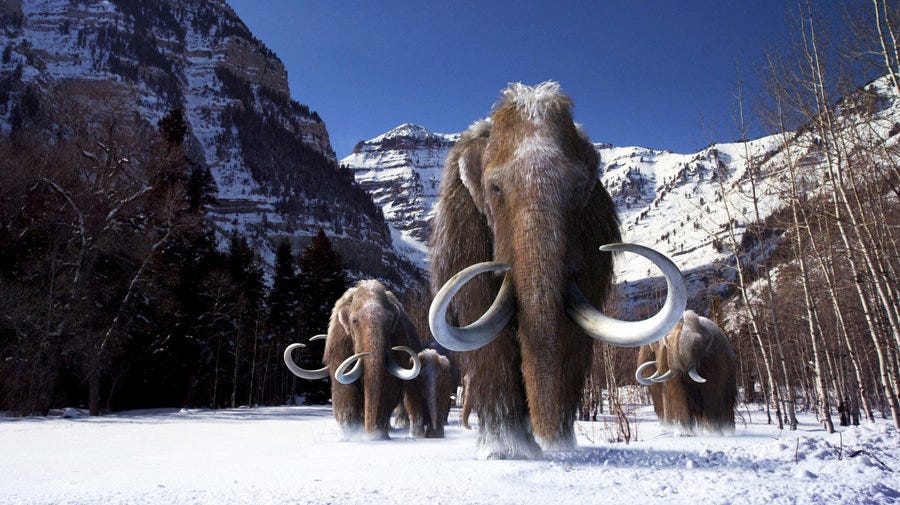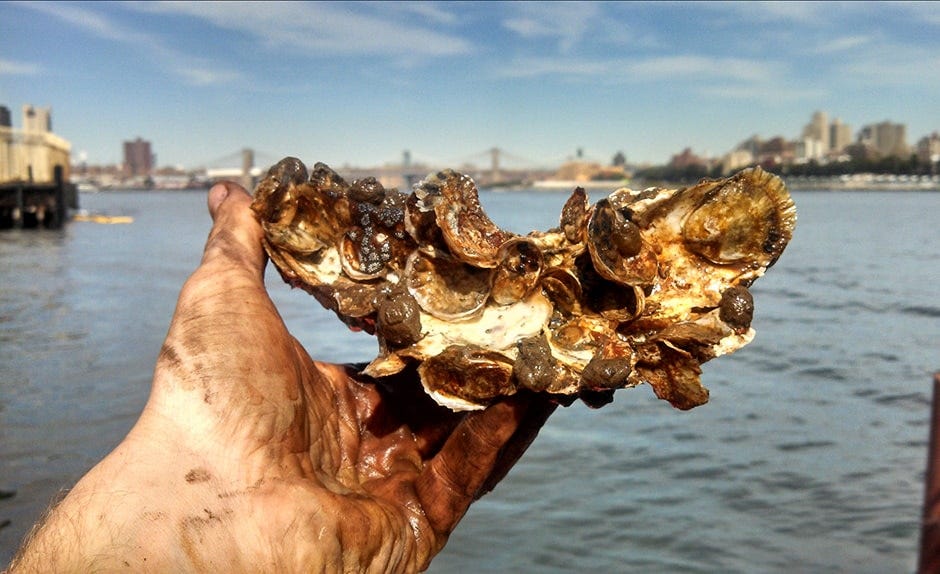The dawn of the age of geoengineering
Let’s be honest. The world’s governments might not coordinate to stop climate change.
Between bickering over which country is paying the bill, the fact that the major costs of climate change are decades away, and countless more urgent political problems caused by the sudden surge of populism around the world, it’s possible sensible policies like carbon taxes won’t be fully adopted in time.
Fortunately, technology and entrepreneurship are contributing solutions. Solar and wind energy is plummeting in price. Transport is electrifying because it turns out electric cars are simply better than conventional ones.
But also, there is still a chunk of humanity with the determination, audacity, and ingenuity to succeed on a massive scale where political coordination has so far failed. Meet the geoengineers.
Here are four of my favorite large-scale projects to improve Earth’s environment.

Pleistocene Park
I’ve been following the effort to bring Mammoths back to Siberia since 2017 when I read Ross Andersen’s spellbinding feature on the subject in The Atlantic (highly suggested).
The core idea is delightfully counterintuitive: Siberia has too many trees. In ages past, Siberia used to be grassland, and today it is mostly forest. Although trees can sequester carbon in their trunks and branches (at least until they burn or decompose), Siberian forests have significant drawbacks with respect to climate change.
First, forests don’t reflect a lot of solar radiation. A treeless, grassy Siberia would increase Earth’s albedo, reflecting more solar energy back into space. Forests absorb more solar radiation and put it into the ground as heat.
Second, forests are poor habitats for snow-trampling herd animals. In the winter, a thick layer of snow acts as an insulator on the permafrost, preventing frigid above-ground temperatures from reaching deep into the Earth’s crust, where they can shore up the frozenness of the permafrost. When large herds of grazing animals trample the snow, its insulating properties are reduced and the permafrost can hard freeze. Forests reduce these snow-trampling grazing populations.
These effects matter because Arctic permafrost is potentially a carbon bomb. Legions of microbes lay in suspended animation in the frozen soil. If the temperature of the soil rises only 3 more degrees (C), the microbes will come to life, eat, reproduce, and start generating carbon emissions. Arctic permafrost contains more carbon than all the planet’s forests and the atmosphere combined. Thawing permafrost could therefore be a tipping point, leading to significantly more carbon in the atmosphere and a runaway warming scenario. An increase in albedo from converting the terrain to steppe would mean that the Siberian permafrost would absorb less heat, allowing it to stay frozen longer. And the trampled snow from the return of herding animals would allow Siberia’s frigid winter air to keep the permafrost deep-frozen.
So how do we convert Siberia to grassland? Nikita Zimov is already doing it. He is director of Pleistocene Park, a 144 km² grassy Siberian reserve founded by his father, gonzo scientist Sergey Zimov. The Zimovs have spent the past two decades ripping up trees and reintroducing grazing herds, including bison, moose, wild horses, yaks, and reindeer.
The plan is working. Nikita Zimov says the permafrost, which is at around –3º outside the park, is 17º colder (!) inside the park. The question then, is how to expand the park as efficiently as possible.
Here’s where the project gets really audacious: the plan is to bring back woolly mammoths. Like much other megafauna, mammoths died out around 10,000 years ago, hunted to extinction by our human ancestors. Mammoths provided the Pleistocene with the valuable services of grazing, trampling snow and moving it around to get to the grass below, and uprooting trees. Nothing will make a mammoth happier, it is thought, than ripping a tree out of the icy ground, just as modern elephants enjoy doing the same in the warmer ground of Africa. Based on everything we know, mammoths were a critical part of the Siberian Steppe ecosystem, and their extinction at human hands is what caused the forests to take hold.
To bring back woolly mammoths, we don’t need mammoth DNA perfectly preserved in amber as in Jurassic Park. Instead, geneticists are starting from mammoths' closest living relative, the Asian elephant, and adding genes that provide traits that could help them to survive in cold climates. If we give Asian elephants a nice layer of subcutaneous fat, a thicker coat of hair, smaller ears (so that the extremities don’t freeze), and some hemoglobin adapted for the cold, that may be enough to allow them to survive in the cold, Siberian winter. Modify perhaps as few as 50 genes. From there, it is thought, evolution will resume and make them more mammoth-like.
This genetic work is going on at the Wyss Institute at Harvard, led by ubiquitous geneticist George Church. There, scientists are identifying genes that could aid winter survival of Asian elephants, CRISPRing them into living elephant fibroblasts, and reprogramming the fibroblasts into pluripotent stem cells. These stem cells, with luck, will be used to produce new “mammoth” embryos. Once enough likely-to-survive mammoth-like elephants are incubated (artificially, because Asian elephants are endangered) to form a herd, they can be released into Pleistocene Park to help transform, maintain, and expand it—and, over a few generations, to transform themselves into better mammoths.
Humans have had a significant impact on the climate by deploying fossil fuels. But the key insight of the Zimovs is that our climate impact started much earlier, during the Paleolithic era, when we hunted megafauna to extinction and therefore altered critical ecosystems. Some environmentalists don’t like geoengineering because it seems too easy: perhaps it ignores the sins of humanity, for which we must atone. But in fact, using genetic engineering to revive megafauna that we wiped out to restore ecoystems that benefit the climate also atones, if that is the right way of looking it at. Hunting these magnificent creatures to extinction was our original climate sin.

Project Vesta
Earth has a built-in geological system for removing CO₂ from the atmosphere. It’s called the carbonate-silicate cycle, and it is the reason volcanic carbon emissions did not burn Earth to a crisp long before humans even domesticated fire. The only problem with this cycle is that it operates over a period of millions of years, too long to absorb the high rate of anthropogenic emissions. The aim of Project Vesta, based on scientific research led especially by Dutch geologist R. D. (Olaf) Schuiling, is to dramatically shorten that time frame.
The carbonate-silicate cycle is fairly simple to understand. As volcanic rock is broken down by water, the reaction’s byproducts combine with atmospheric CO₂ to form bicarbonate, which (in addition to deacidifying the ocean) is used by marine life to produce carbonate-rich sediments that fall to the ocean floor. These sediments stay there until they are absorbed into Earth’s crust and emitted again as volcanic lava many millions of years later. Unlike planted trees, which release stored carbon when they burn in forest fires or decompose after dying, the process of transforming atmospheric CO₂ into undersea limestone which is then subducted back into the Earth’s core can well and truly sequester carbon for eons.
This process happens naturally, but to move the needle on climate change, we need to accelerate it. What Project Vesta proposes is to mine large volumes of a (usually) green mineral called olivine, crush it up, and spread the resulting green sand on beaches all over the world, especially in the tropics where the water is warmest. Tumbled in warm, fast-moving water, this green sand would rapidly weather, essentially undergoing millions of years of the natural carbonate-silicate cycle in a few months or years.
It’s a little strange to think of turning our beaches green, but on reflection that isn’t a major objection. Papakōlea Beach in Hawaii is one of four beaches in the world that naturally features green olivine sand. And Project Vesta estimates that to offset all the world’s annual emissions, only 2% of the world’s shelf seas are needed.
Logistically, the plan seems at least plausible. One ton of olivine applied in Vesta’s process removes around 1.25 tons of CO₂ from the atmosphere. Olivine is superabundant, making up about half of Earth’s upper mantle, and currently costs around $25/ton to mine. At greater mining scale, mining and crushing olivine could be done for around $7/ton. Add around $3/ton for transport and logistics and you still have 1.25 tons of CO₂ removed from the atmosphere for about $10, or $10.62 as the detailed Project Vesta model has it). The Vesta team admits that a full life cycle analysis would lose up to 6% of the CO₂ saved, due to mining, milling, and transport. Even so, that works out to around $9.04 per ton of CO₂ removed from the atmosphere and ocean.
Are Project Vesta’s assumptions regarding economies of scale in mining realistic? Maybe. As organizations in the Netherlands such as greenSand have started to promote olivine weathering as a climate solution, the volume mined has gone up and the price has gone down. And the mining model Project Vesta points to for its $7.32/ton estimate is based on similar volcanic rocks and assumes US labor costs, which may actually be higher than what is realized if Vesta succeeds.
Let’s run some numbers assuming the $9.04/ton figure based on Project Vesta’s estimates. Say we wanted to offset 40 gigatons of CO₂, close to the average global annual level of CO₂ emissions. Per Project Vesta’s at-scale model, that would cost around $360 billion. That is a lot of money, but it’s less than, say, US annual defense expenditures, around one tenth of what the US pays for healthcare annually, or 0.4% of global GDP (which is around $88T and growing).
And how about if we wanted to offset cumulative anthropogenic emissions since 1751? As of 2017, that was close to 1.6 trillion tons of CO₂. 1.6T × $9.04 = $14.46T through 2017. Adding $360B for each of 2018 and 2019, we arrive at a one-time cost of $15.18T for offsetting all human emissions since the dawn of the industrial revolution, which if done over 10 years, would cost 1.7% of global GDP.
If Project Vesta’s estimates are right, humanity would completely solve the problem of climate change. To my eyes, it seems dirt cheap compared to many other proposals to respond to climate change (YC estimates direct air capture costs are $94/ton), and it is feasible using only technology that exists today. Even the skeptics among us should be intrigued.

Prometheus Fuels
Not all geoengineering megaprojects have to be non-profit. In October of last year, YCombinator put out a call for carbon removal startups to fund. One of my favorite companies that came out of this batch of startups is Prometheus Fuels.
The proposition Prometheus offers is simple: zero-carbon gasoline, for around $3/gallon. The company literally takes air and clean electricity and turns it into ethanol, butanol, or propanol, which can then be transformed into other fuels.
Turning atmospheric carbon dioxide into something more useful, like ethanol, is a known chemical reaction. As founder Rob McGinnis noted in his Hacker News launch post, “We’re not the first to make fuel from the air—in fact Google, Audi, Carbon Engineering, Global Thermostat, Climeworks, and labs at universities and national labs have all done it before us.” The process is essentially, as a story in Science put it, combustion in reverse: CO₂ and water react to form carbonic acid, and exposing carbonic acid to electricity and a copper catalyst can yield ethanol in a solution of water. From ethanol, we know how to upgrade the carbon chains to something like gasoline or jet fuel.
The big problem is that this process produces ethanol in water. The traditional way to separate ethanol from water is known as fractional distillation. You raise the temperature of the mixture beyond the boiling point of ethanol (173.3 ºF) and below the boiling point of water (212 ºF). This means the ethanol is in gas form and the water is in liquid form, and you can separate them. It takes energy to raise the temperature of the mixture, and this makes the whole process uneconomical.
Prometheus’s innovative ethanol/water separation mechanism, in contrast, operates at room temperature. The company has a proprietary way to produce filters from carbon nanotubes that let ethanol through but block water. As a result, no significant energy input is needed to isolate the ethanol. This means that Prometheus can produce ethanol from atmospheric CO₂ cheaply. The company estimates that gasoline made with their process, once equipment manufacturing is scaled, will be available for $3/gallon. Other liquid hydrocarbons like jet fuel would presumably cost a similar amount.
Assuming that only clean energy is used in Prometheus’s process, the resulting fuel is zero-carbon on a net basis. It is chemically identical to conventional fuel, so when it is burned CO₂ is released into the atmosphere. But the carbon atoms in the CO₂ molecules came from atmospheric CO₂ in the first place. Over the lifecycle of the fuel, the net effect on atmospheric CO₂ levels is zero.
Prometheus launched targeting the gasoline market, worth about $2 trillion per year. “We want to replace all fossil gasoline,” says McGinnis. But with cars perhaps on the cusp of rapid electrification, whether in the next 5 or 15 years, I am most excited about their technology in aviation.
Aviation is much harder to electrify than cars because of its extreme weight-sensitivity. Batteries simply can’t beat liquid hydrocarbons on specific energy. Due to improvements in battery specific energy, there is now a huge amount of investment in electric urban air mobility. And there are a handful of electric short-haul airliner projects like Eviation’s Alice and Heart Aerospace. But the math just doesn’t add up on long-haul.
Let’s take the Boeing 787-9, which has a range of up to 7,635 nmi. Its fuel capacity is 33,384 gallons (or 101,456 kg) of Jet A. Jet A has specific energy of 43 MJ per kg. This means that a fully loaded 789 carries 4,362,608 MJ or 4.36 TJ on board. The best lithium-ion batteries have a specific energy of less than 1 MJ/kg. Experimental lithium metal or lithium-sulfur batteries can yield up to around 1.8 MJ/kg. Assuming the better experimental battery technology, the aircraft would need 2,423,671 kg of batteries to replace the energy from Jet A. Considering the 789’s maximum takeoff mass is 254,011 kg, that is not close to possible. And even if you somehow could fit all the batteries on board, it would take yet more energy to fly with all that added weight.
So long-haul aviation will rely on carbon-based fuels for many decades to come. Aviation accounts for only around 3 percent of the world’s carbon emissions, but it is also one of the hardest applications to get off of liquid hydrocarbons. With Prometheus fuels, zero-carbon flights would be possible in only a few years. That is important because the world has already agreed to cap the industry’s (international) emissions to 2020 levels under the CORSIA framework, offsetting any overages. And Prometheus’s zero-carbon fuel would go a long way toward reducing (misplaced) guilt over travel due to flight shaming. The industry will gladly pay for zero-carbon fuels; the problem so far has been getting them at scale.
Another advantage for using Prometheus fuels in aviation is that ASTM, the standards body, has already developed a standard for alcohol-to-jet drop-in sustainable fuels. This means that Prometheus jet fuel could—right now—be used as a drop-in substitute for any aircraft that accepts Jet A in its flight manual, in a blend ratio up to 50%. In a safety-obsessed industry, there are no regulatory barriers to using this new, zero-carbon fuel. Over time, the allowed blend ratio is expected to go up to 100%, as the fuels really are chemically identical.
Although I expect cars and truck to go fully electric in a matter of years, the jet fuel market is pretty big too. Commercial airlines use 97 billion gallons of jet fuel per year, and that is not going away soon. If in our lifetimes we get zero-carbon aviation, it will be due to technology like Prometheus’s.

The Billion Oyster Project
Oysters are incredible creatures. Not only are they delicious on the half shell, during their time in the ocean each one filters between 30 and 50 gallons of water per day. They are also a keystone species, providing enormous benefits in terms of maintaining the structure of their ecosystem, forming reefs that provide habitats for other aquatic life, and otherwise supporting marine biodiversity.
New York harbor used to brim with oysters. When Henry Hudson first entered the harbor in 1609, it had 220,000 acres of oyster reefs. And they were large oysters too—the Lenape tribe had been plucking oysters out of the harbor for centuries, and we know from Lenape middens that the oyster shells were up to 10 inches in length. Some biologists estimate that New York harbor once contained half the world’s oysters. The water was pristine, the harbor teemed with life.
For most of New York’s history, it was known for its oysters. The Big Oyster is an entire book by Mark Kurlansky on the history of oysters in New York. Forget hot dog stands. Oysters were the original New York street food. And the oyster cellar was a ubiquitous eatery for most of the city’s history. Some catered to the affluent, and some to the working class. Everyone ate oysters.
What changed? Despite some problems with overharvesting, oyster populations were still strong into the 1800s. Around 1880, New York City was producing 700 million oysters per year, both for consumption and export. Pollution dealt the biggest blow. By the early 1900s, 600 million gallons of untreated sewage were dumped into city water per day. That was bad. Then came the industrial pollutants like heavy metals and polycholorinated biphenyls, many of them dumped into the Hudson River by General Electric. By 1927, the government shut down the harbor’s oyster beds, saying the oysters were no longer safe to eat. Soon after, the oysters died out.
In 1972, the Clean Water Act put an end to the worst polluting practices, and today the harbor is clean enough to sustain new oysters. The Billion Oyster Project, founded by Murray Fisher and Peter Malinowski and based out of the New York Harbor School, aims to reintroduce and foster a billion oysters in New York harbor. Thousands of middle and high school students have participated. Already, they have restored 28 million oysters, 2.8% of the way to their final goal. The project aims to reach its goal of one billion oysters by 2035.
It is fascinating to think about what a billion oysters in New York harbor could do. There are around 74 billion gallons of water in New York harbor, so a billion oysters could filter the entire harbor every two days or so. Because of lower pollution levels, we are already starting to see whales and dolphins return to the harbor. That is hardly attributable to the 28 million oysters restored so far, but it is fun to imagine a pristine harbor, fully cleansed by a billion bivalves, teeming with all kinds of sea life.
Oyster reefs have an additional benefit, one that relates to climate change: they serve as breakwaters to prevent storm surges. A billion oysters in New York harbor would restore some of the city’s protection from hurricanes.
A warmer climate is expected to increase the impacts of hurricanes, mainly by affecting their intensity. Model predictions are highly uncertain, ranging from a 39 to an 87 percent increase in the frequency of category 4 and 5 storms in the Atlantic basin, but the basic idea makes sense: warmer waters provide storms with more energy and more rain, making storms more destructive.
In 2012, New York City got slammed with a doozy of a storm called Hurricane Sandy. The subways flooded. NYU Hospital had to be evacuated because a backup generator failed due to flooding. All but one road tunnel into Manhattan flooded. People died. The economic losses in New York City alone were estimated at $19 billion ($65 billion in the tri-state area).
After Sandy, the need for breakwaters became obvious, and officials recognized the potential for the Billion Oyster Project to help provide that capability in Tottenville, Staten Island. And if the whole harbor could be restored to its former oysterfull glory, perhaps the next hurricane would not be as damaging for the city as a whole.
The Billion Oyster Project is not totally unique—there is a similar project in effect for the Chesapeake Bay, which also has fewer oysters and dirtier water than it once did. That’s OK. The more oysters the better, in my book.
Conclusion
What I love about these projects is not just their effects—improvement of the environment and climate—but their ambition, scale, and creativity. The world needs megaprojects.
My hope is that we can get to a point where more people think at megaproject levels of ambition, even when there isn’t a crisis to which to respond.




